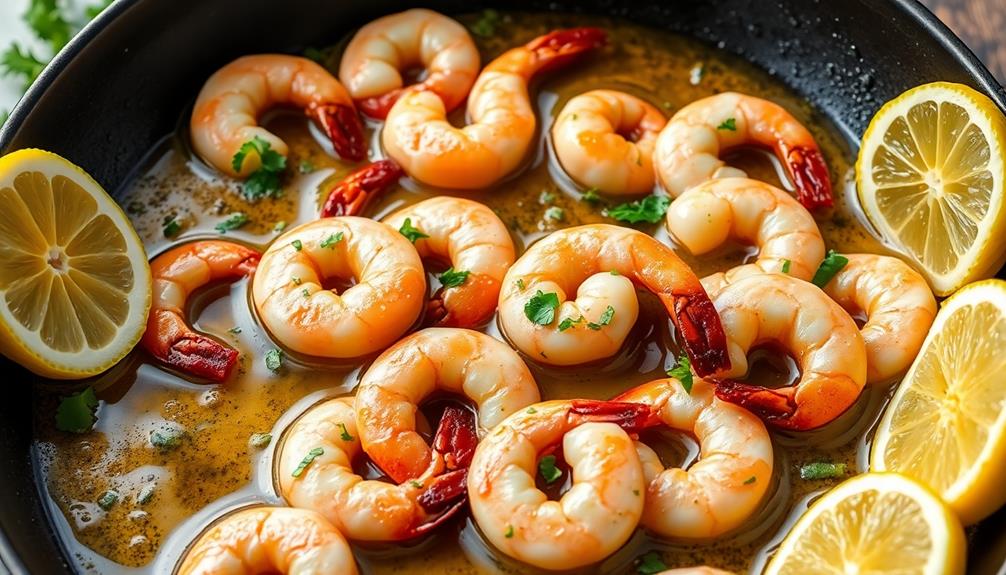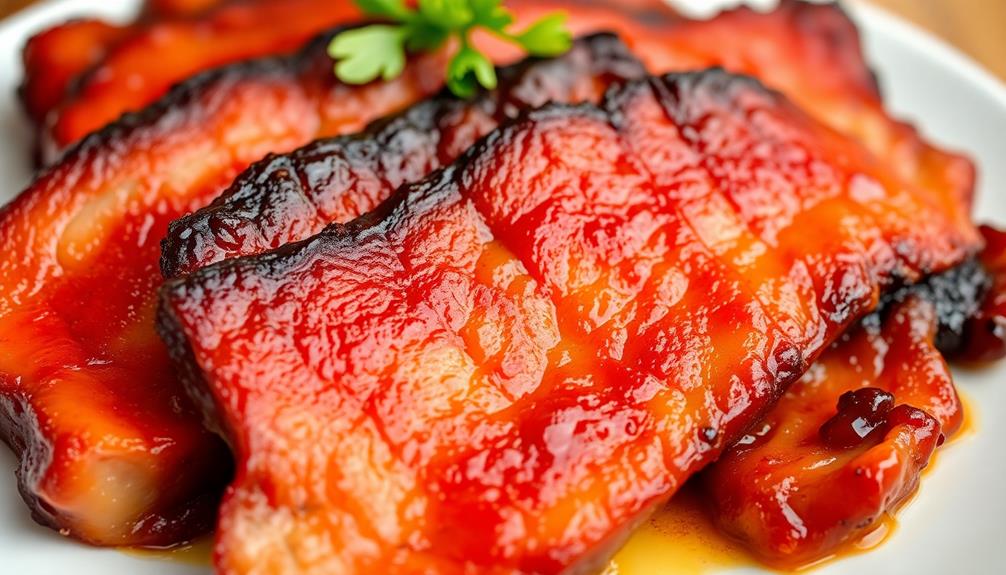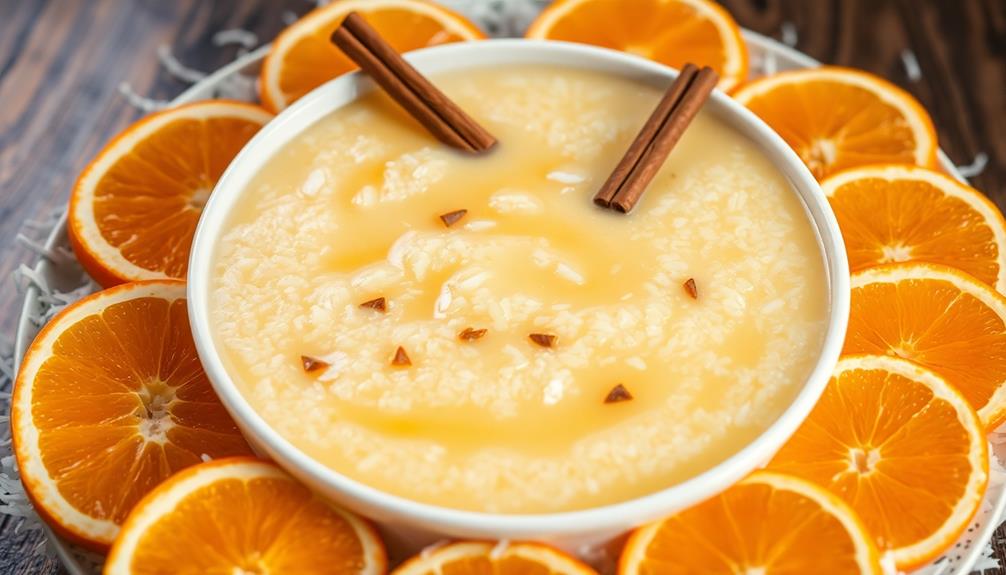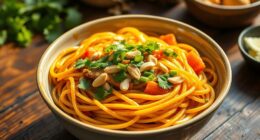Originating from the Iberian Peninsula, gambas al ajillo, or garlic shrimp, is a beloved tapas dish that showcases the harmonious balance of fresh shrimp, aromatic garlic, and vibrant spices. You'll start by sautéing garlic and red pepper flakes in olive oil until golden, then adding the shrimp to cook until pink and opaque. Deglaze the pan with white wine for extra flavor, and finish with a sprinkle of paprika. Garnish with chopped parsley, and serve with crusty bread to soak up the delicious oil. This versatile dish is perfect as an appetizer or main course – you'll want to keep reading to discover more about its rich history and serving suggestions.
Key Takeaways
- Gambas al Ajillo is a traditional Spanish tapas dish featuring shrimp sautéed in olive oil with garlic, paprika, and red pepper flakes.
- The dish originated in the Iberian Peninsula and has become a staple in Spanish cuisine, often served as a sharing plate.
- Key ingredients include fresh shrimp, high-quality olive oil, garlic, paprika, and red pepper flakes, with optional additions like lemon juice and parsley.
- Proper preparation techniques, such as avoiding overcooking the shrimp, are essential for achieving the best flavor and texture.
- Gambas al Ajillo is a versatile dish that can be served as an appetizer, main course, or paired with other Spanish dishes and wines.
History
Originating in the Iberian Peninsula, gambas al ajillo traces its roots back to the traditional Spanish tapas dish. This beloved garlic shrimp delicacy has been enjoyed for centuries, evolving from humble beginnings.
Initially, it was a simple and affordable meal, relying on readily available ingredients like olive oil, garlic, and shrimp. Over time, as the dish gained popularity, variations emerged, with chefs experimenting with different seasonings and cooking techniques.
The dish's name, "gambas al ajillo," reflects its core elements – gambas meaning shrimp, and ajillo referring to the garlic. This straightforward yet flavorful combination has become a staple in Spanish cuisine, often served as a sharing plate or alongside other tapas.
Its versatility has also led to its adoption in various regional cuisines, each bringing their own unique twist to the classic recipe.
Recipe
Gambas al ajillo, or garlic shrimp, is a classic Spanish tapas dish that showcases the simple yet flavorful combination of fresh shrimp, garlic, and olive oil. This dish is beloved for its bold, garlicky taste and its ability to transport you to the lively streets of Spain with each bite.
The key to a truly exceptional gambas al ajillo lies in the quality of the ingredients and the care taken in their preparation. By using the freshest shrimp available and allowing the garlic to infuse the oil, you can create a dish that's both elegant and deeply satisfying.
- Shrimp, peeled and deveined
- Garlic cloves, thinly sliced
- Olive oil
- Paprika (sweet or smoked)
- Salt and pepper to taste
- Crusty bread, for serving
In a large skillet, heat the olive oil over medium heat. Add the sliced garlic and sauté until fragrant and just starting to turn golden, about 1-2 minutes, being careful not to burn the garlic.
Add the shrimp to the pan and cook, stirring occasionally, until the shrimp are opaque and just cooked through, approximately 3-5 minutes. Sprinkle in the paprika and season with salt and pepper to taste.
When serving, be sure to have plenty of crusty bread on hand to soak up the flavorful garlic oil. For the best experience, enjoy the gambas al ajillo immediately, while the shrimp are hot and the garlic is at its most aromatic.
The dish can be further enhanced by a squeeze of fresh lemon juice or a sprinkle of chopped parsley, if desired.
Cooking Steps
Peel and devein the shrimp, removing the shells and veins.
Next, sauté the garlic in olive oil until it's fragrant.
Now, add the shrimp and let them cook until they turn pink, then splash in some white wine.
Step 1. Peel and Devein Shrimp
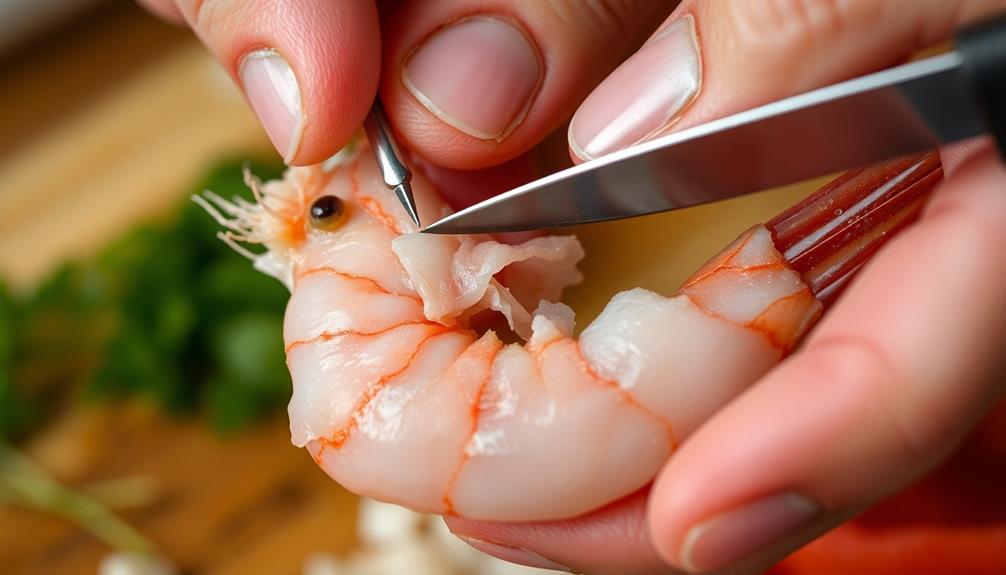
To prepare the shrimp, you'll first need to peel and devein them. Start by grabbing a shrimp and gently pinching the tail end. Slowly peel off the shell, working your way from the tail to the head. Be careful not to tear the flesh.
Once the shell is removed, use a small, sharp knife to make a shallow cut along the back of the shrimp. This will expose the dark vein, which you can then remove by gently pulling it out.
Repeat this process with each shrimp, placing the peeled and deveined ones in a bowl as you go. It's a bit of a tedious task, but it's an essential step to ensure your Gambas Al Ajillo turns out perfectly.
Once all the shrimp are prepped, you're ready to move on to the next stage of the recipe. Just remember to work carefully and take your time to get those shrimp nice and clean.
Step 2. Sauté the Garlic
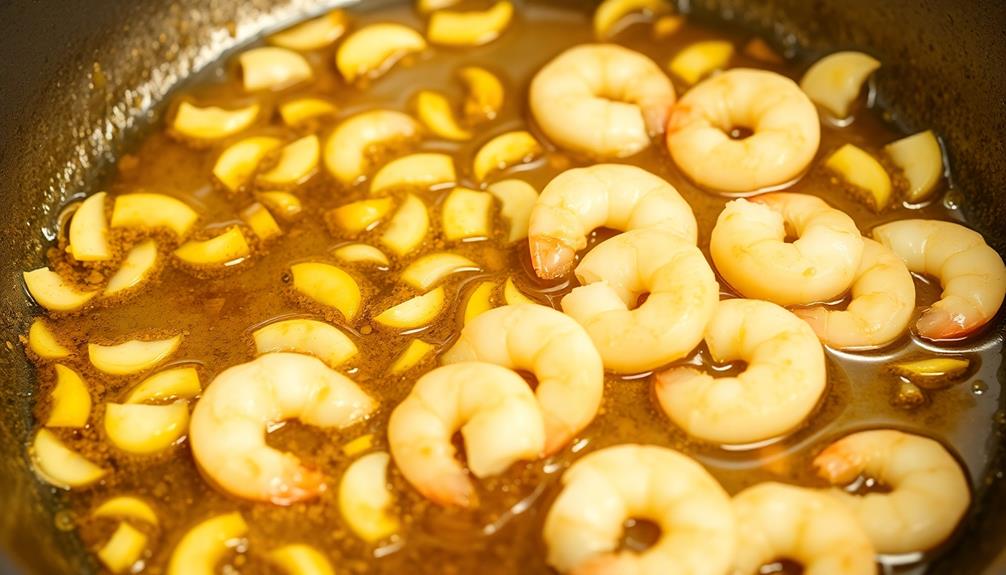
Next, you'll sauté the garlic. In a large skillet or wok, heat a few tablespoons of olive oil over medium heat.
Once the oil is shimmering, add the peeled and minced garlic. Stir the garlic constantly, making sure it doesn't burn. You want the garlic to turn golden brown and become fragrant, which should take about 1-2 minutes.
Be careful not to let the garlic overcook, as it can quickly turn bitter. Once the garlic is perfectly sautéed, remove the skillet from the heat. This will stop the cooking process and prevent the garlic from burning.
The sautéed garlic will add a wonderful depth of flavor to your Gambas al Ajillo dish.
Now that the garlic is ready, you can proceed to the next step – adding the shrimp to the pan and cooking them to perfection.
Get ready for the mouthwatering aroma and delicious flavors that are about to unfold!
Step 3. Add the Shrimp
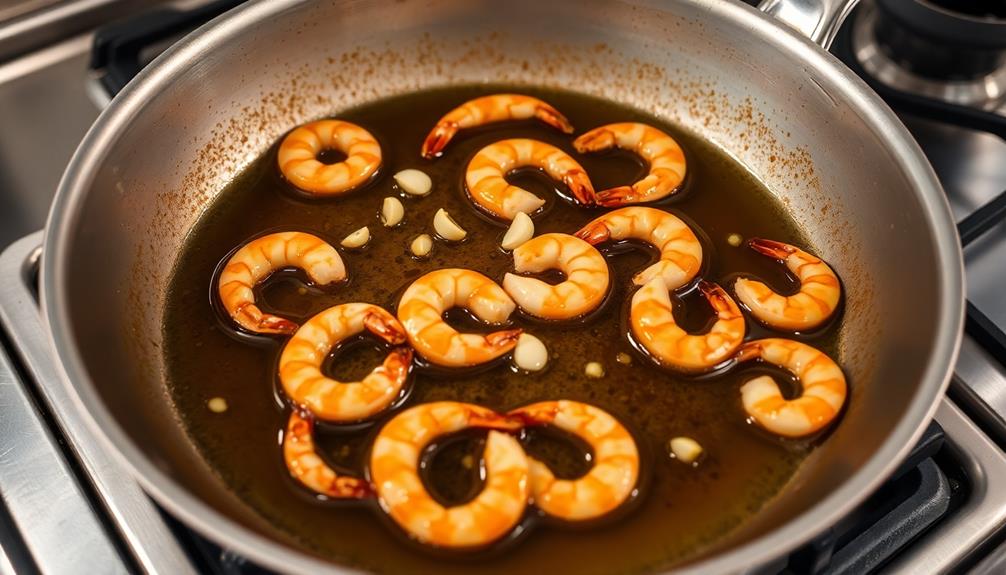
With the garlic perfectly sautéed, you can now add the shrimp to the pan. Carefully drop the shrimp into the hot oil, making sure they're in a single layer.
Don't overcrowd the pan – work in batches if needed. Let the shrimp sear for about a minute, then flip them over to cook the other side. They should turn pink and start to curl up.
Once the shrimp are cooked through, which should take just a few minutes, remove the pan from the heat. The residual heat will continue cooking them, so be careful not to overdo it.
You want the shrimp to be opaque and tender, not rubbery. Give them a gentle stir to coat them in the garlic-infused oil. At this point, the mouthwatering aroma of the garlic shrimp should start wafting through your kitchen, making your taste buds tingle with anticipation.
Step 4. Add White Wine

After the shrimp have had a chance to sear, you can now introduce a splash of white wine to the pan. This will help deglaze the flavorful bits stuck to the bottom, creating a rich, aromatic sauce. The wine will also help tenderize the shrimp, ensuring they remain juicy and delectable.
Pour in about 1/4 cup of dry white wine, such as sauvignon blanc or pinot grigio. Swirl the pan to distribute the wine evenly, then let it simmer for 2-3 minutes. The alcohol will cook off, leaving behind a wonderful wine-infused flavor.
As the sauce reduces, you'll notice it becoming slightly thicker and more concentrated. This is the perfect time to taste and adjust the seasoning if needed, perhaps adding a pinch more salt or a squeeze of lemon juice.
The end result should be a silky, garlic-infused sauce that coats the shrimp beautifully, ready to be soaked up with crusty bread.
Step 5. Season With Paprika
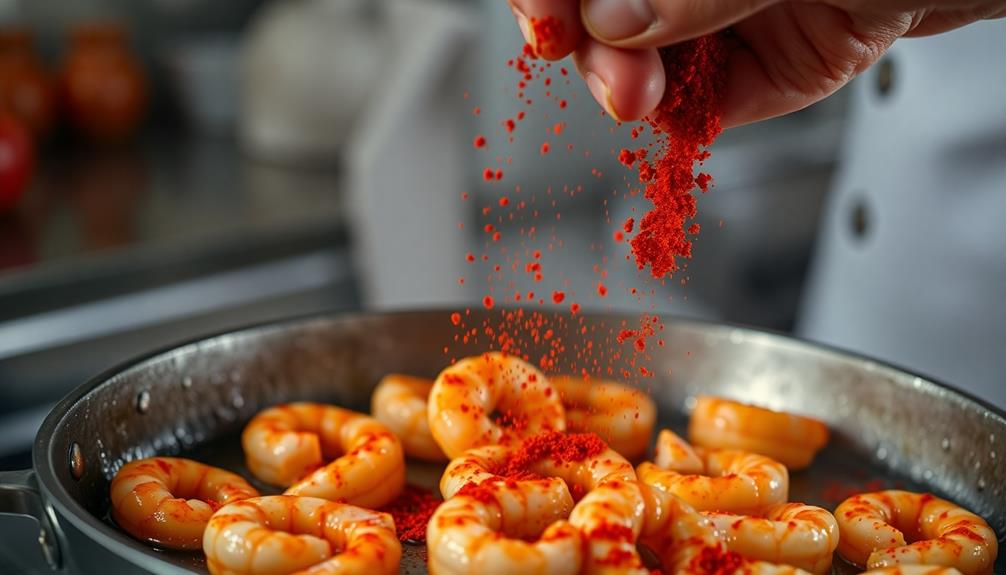
The shrimp's smoky paprika seasoning comes next. Sprinkle a generous amount of sweet paprika over the garlic-infused shrimp, giving them a vibrant red hue. The paprika's earthy, slightly sweet flavor will complement the garlic beautifully.
Be sure to evenly coat each shrimp, so every bite bursts with that bold, smoky-sweet seasoning.
Next, grab a pinch of smoked paprika and add it to the mix. This will lend a subtle hint of campfire-like smokiness that takes the dish to new levels of flavor.
Gently toss the shrimp to ensure the paprika is well distributed. The combination of sweet and smoked paprika creates a mouthwatering spice blend that will have your taste buds dancing.
Final Thoughts
Gambas al ajillo is a simple yet flavorful dish that showcases the best of Spanish cuisine. Whether you're hosting a lively tapas party or enjoying a cozy evening at home, this garlicky shrimp dish is sure to delight.
The combination of succulent shrimp, fragrant garlic, and a touch of paprika creates a mouthwatering experience that's hard to beat. As you savor the final bites, you'll appreciate the way the flavors meld together, creating a harmonious balance that lingers on your palate.
The dish's versatility means it can be enjoyed as an appetizer, a main course, or even incorporated into larger meals. Plus, the quick cooking time makes it an ideal option for busy weeknights or last-minute gatherings.
Whether you serve it with crusty bread for sopping up the flavorful oil or alongside a crisp salad, gambas al ajillo is a true gem of Spanish cuisine that's sure to become a new favorite in your culinary repertoire. Looking for more Spanish culinary delights? Try pairing gambas al ajillo with a traditional Spanish cold soup recipe like gazpacho or salmorejo. The combination of the garlicky shrimp with the refreshing, tomato-based soup is a match made in heaven. You’ll find yourself transported to the streets of Spain with every delicious bite.
Frequently Asked Questions
Can I Use Frozen Shrimp Instead of Fresh?
You can absolutely use frozen shrimp instead of fresh. In fact, frozen shrimp can be just as delicious and convenient, especially when you don't have access to fresh seafood. Just be sure to thaw it properly before cooking.
Is It Possible to Make This Dish Vegetarian?
You can absolutely make this dish vegetarian! Simply swap out the shrimp for your favorite firm vegetables or plant-based protein like tofu or tempeh. Adjust the cooking time as needed, and you'll have a delicious meatless version.
How Long Will the Leftover Shrimp Last in the Fridge?
Leftover shrimp can last 3-4 days in the fridge when stored properly in an airtight container. Make sure to consume them within that timeframe to ensure food safety and avoid any potential health risks.
Can I Use a Different Type of Oil Instead of Olive Oil?
You can absolutely use a different type of oil instead of olive oil. Vegetable, canola, or even coconut oil would work well in the dish you're preparing. The key is choosing an oil that can withstand high heat.
Is It Necessary to Peel the Shrimp Before Cooking?
You don't necessarily have to peel the shrimp before cooking, but it can make the dish easier to eat and enhance the texture. It's a personal preference, so feel free to try it both ways and see which you prefer.
